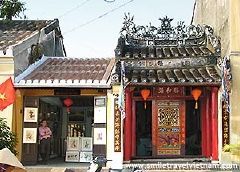
Hoi An is located 30km south of Danang City, and 60 km northeast of Tam Ky. Hoi An used to be an international trade center by sea on the eastwest area in the 16th and 17th centuries. It was the busiest trading port in Dang Trong region of Vietnam under the reign of Nguyen as merchants from Japan, China, Portugal, Spain, Holland...often landed for exchanging, purchasing commodities. In the historical progress of establishment and development, Hoi An was known by foreign merchants as Faifo, Haisfo, Hoai pho, Ketchem, Cotam. Based on archeological relics and architecture documents, Hoi An was not only a place of converge and exchanging of many cultures such as: Champa, Vietnamese, Portuguese, Japanese and Chinese, especially impacted most by Vietnamese and Chinese civilisations.
Hoi An Ancient Town is an exceptionally well-preserved example of a South-East Asian trading port dating from the 15th to the 19th century. Its buildings and its street plan reflect the influences, both indigenous and foreign, that have combined to produce this unique heritage site.
Up to now, the ancient town of Hoi An intactly preserves its original architectures, including houses, temples, pogodas, streets, ports, civil buildings, religious structures and other non-religious worshipping structures. The every day lifestyle with deep-rooted customs and cultural activities is fascinating. Hoi An also attracts tourists thanks to its poetic and picturesque landscapes such as Thuan Tinh islet, Cua Dai beacch, together with traditional handicrafts and famous local specialities.
Hoi An was listed as a world cultural heritage site by UNESCO in December 1999. As statistics shows, in Hoi An there are 1,360 relics and landscapes. These relics are divided into eleven kinds, including 1,068 ancients houses, 19 pagodas, 43 temples, 23 communal houses, 38 family temples, 5 assembly halls, 11 old wells, one bridge, 44 ancient tombs. In old quarter, there are more than 1000 relic sites.
Highlights of Hoian:
- Quan Thang ancient house (77 Tran Phu St.)
- Tan Ky ancient house (101 Nguyen Thai Hoc St.)
- Phung Hung ancient house (04 Nguyen Thi Minh Khai St.)
- Phuc Kien Assembly hall (46 Tran Phu St)
- Trieu Chau Assembly hall (157 Nguyen Duy Hieu St.)
- Quang Dong Assembly hall ( 17 Tran Phu St.)
- Ngu Bang assembly hall ( 64 Tran Phu St.)
- Ong pogoda ( 24 Tran Phu St.)
- Quan Am pogoda (7 Nguyen Hue St.)
- Tran family temple (21 Le Loi St.)
- Historical- cultural museum (7 Nguyen Hue St.)
- Pottery trade museum ( 80 Tran Phu St.)
- Sa Huynh cultural museum (149 Tran Phu St.)

No comments:
Post a Comment